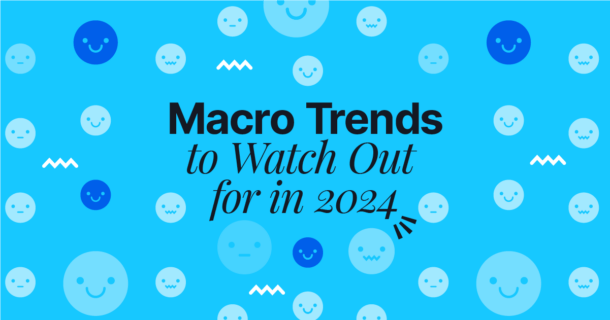Get a designed PDF copy of Consumer Behaviour Macro Trends 2024
Fair warning, this is a relatively long read. If you don’t have the time to take it all in now, you can download the PDF version of Consumer Behaviour Macro Trends 2024 for free by clicking below. Otherwise, just keep reading!

Let’s talk about trends.
Last year, the trends we spoke about were trends we’ve seen before. After the great reset of COVID-19, with the world still wheeling to try and understand how to move forward, humans pivoted towards what they knew, and focused on regaining a little bit of their equilibrium. Trends that we’d already seen years before – the rise of subscription services, the infancy of AI, the ongoing consumer demand for more sustainability and accountability and economical responsibility- cropped up again, with a much louder voice.
2024 is the same. The trends we’re seeing now are trends that we’ve seen before – but they’re taking on new importance in the face of global uncertainty, mass-production of content and the shrinking availability of free time, and the growing discontent of our circumstances.
But there is light, and there is hope.
Here’s how to capture that light.

2024: the year of personality and immersion
The biggest driver for 2024 is AI.
What AI can do. What AI can’t do. How we can leverage AI for better business. What AI tools can help us create more organised, productive lives. Can AI write a better story than a human? What can AI make of this artwork?
The technology available to us in 2023 has pushed the limitations of what we know far higher than we could have anticipated, and we’re heading into 2024 with the full breadth of human capability at our fingertips.
But it’s not the technology that drives consumer behaviour – or at least, not permanently. New technologies introduce consumers to new possibilities, but when it comes to putting their money down, consumers still want the same things:
Personality. Immersion. Quality.

Why do we use trendwatching?
Every business caters to people. Every business has to make money to survive.
Trendwatching is the intersection of where those two facts collide. Trendwatching is what people are doing, what people are interested in, and where they’re spending money. Trendwatching is taking the behaviours of the world as a collective and identifying the big shifts in behaviour that led us to where we are now.
Trendwatching shows you where money is going next, and how your business can get there.
Do I need trendwatching as a small business?
Yes. Every business, at every size, needs trendwatching.
Public opinion moves quickly, and your consumers will change their minds much faster than a business can pivot to meet their demand. People are inspired by the world: they’re always online, always learning, and always repurposing their understanding.
Businesses have to keep up.
How does trendwatching benefit business?
You get to survive another year.
Trendwatching isn’t something you can opt into. Trends exist, whether your business pays attention to them or not. Your consumers change, whether you want them to or not. The least you can do as a business is understand how your consumers are changing, and how to keep speaking to those consumers in a way that makes sense for you, for your business, and for them.
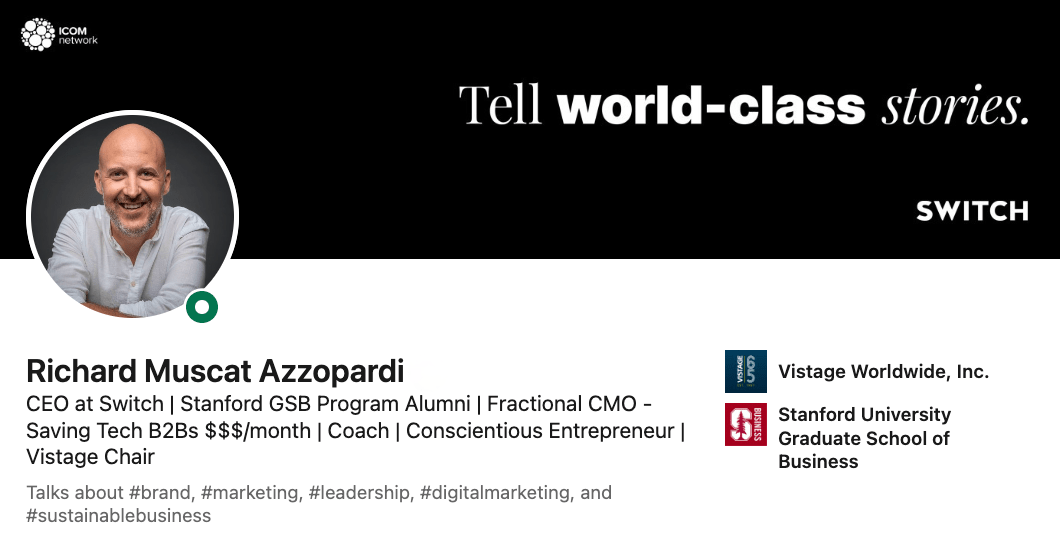
Our CEO on Trends:
“Trends are never the answer for every question your business can have about the future. They’re just another part of a complex set of tools we need to use if we want to stand out in a crowded market. You might read through our trend documents and think that there’s very little that’s of relevance to you today, but I can guarantee that at some point over the next year you’ll come across a situation that you’ll understand a little better, or a problem that you can solve quicker, if you can make sense of it in the framework of a trend that’s affecting the world or your specific industry.
Trendwatching is not speculation. We’re not trying to guess what’s coming in the future. We don’t have a crystal ball.
It’s simply looking out at the world and analysing patterns to help us figure out what’s changing, so that we can change and stay ahead of the curve.
Every year we work on trendwatching we realise that it’s becoming even more of an acute need. The past three years have shaken so many of our beliefs, and they’ve reinforced so many others, that trendwatching has become an essential part of what we do, and we believe that it should be a part of what you do, too.
As the world evolves at an ever-faster pace, the only thing we can do is our utmost to keep ahead of it, moving at breakneck speed to keep up with what we see as the major shifts impacting people’s behaviour.”

A snapshot of 2023:
The year is 2023.
The global cost-of-living crisis continues to impose stricter limitations on the consumer body as a whole. Wars, and the continuing climate change crisis have led to a largely despondent consumer body that’s inundated with bad news.
A proliferation of AI tools has led to the creation of far more content, but with it comes a wider-spreading circle of misinformation that businesses and consumers parse through have to at unprecedented rates. The internet has shrunk significantly, with fewer online spaces to spend time in without being encouraged to purchase.
Consumers are tired, pushed to the brim of what they can withstand, and looking for brands that will commiserate with them. Lacking admirable public figures and trust in the government, brands have extended beyond their use as a public value identifier and become more or less the only institutions that consumers trust to bring about real change.

Macro Trend 1: Immersion over innovation
- 56% of consumers consider immersive environments to be better than traditional social media for advertising.
- 44% of consumers have tamped down on spending except for experiential purchases.
- There is a 7% increase in consumers who state they will make repeat purchases after a personalised shopping experience, bringing the total to 56% of consumers in 2023.
Think about the last product you’ve purchased.
What do you remember from that exchange? We’re willing to bet it wasn’t how you paid.
Consumers are drowning in technology. Our lives have never been so optimised, connected, or crafted in living memory, and as a result, we’re seeing a lot of technology-based burnout when it’s all that’s been on the news for the last handful of months.
On the other hand, brands that leverage that technology to create an experience where the technology isn’t at the centre have seen some impressive reactions.
We can never go back to a world without the technology that we know and have available – but it’s no longer what pulls money in.
Immersion does. Brand experiences that pull people into a little microuniverse of their own can attract lifelong consumers: ones that will keep coming back to you not just because of your product, but because of the way you sell that product.
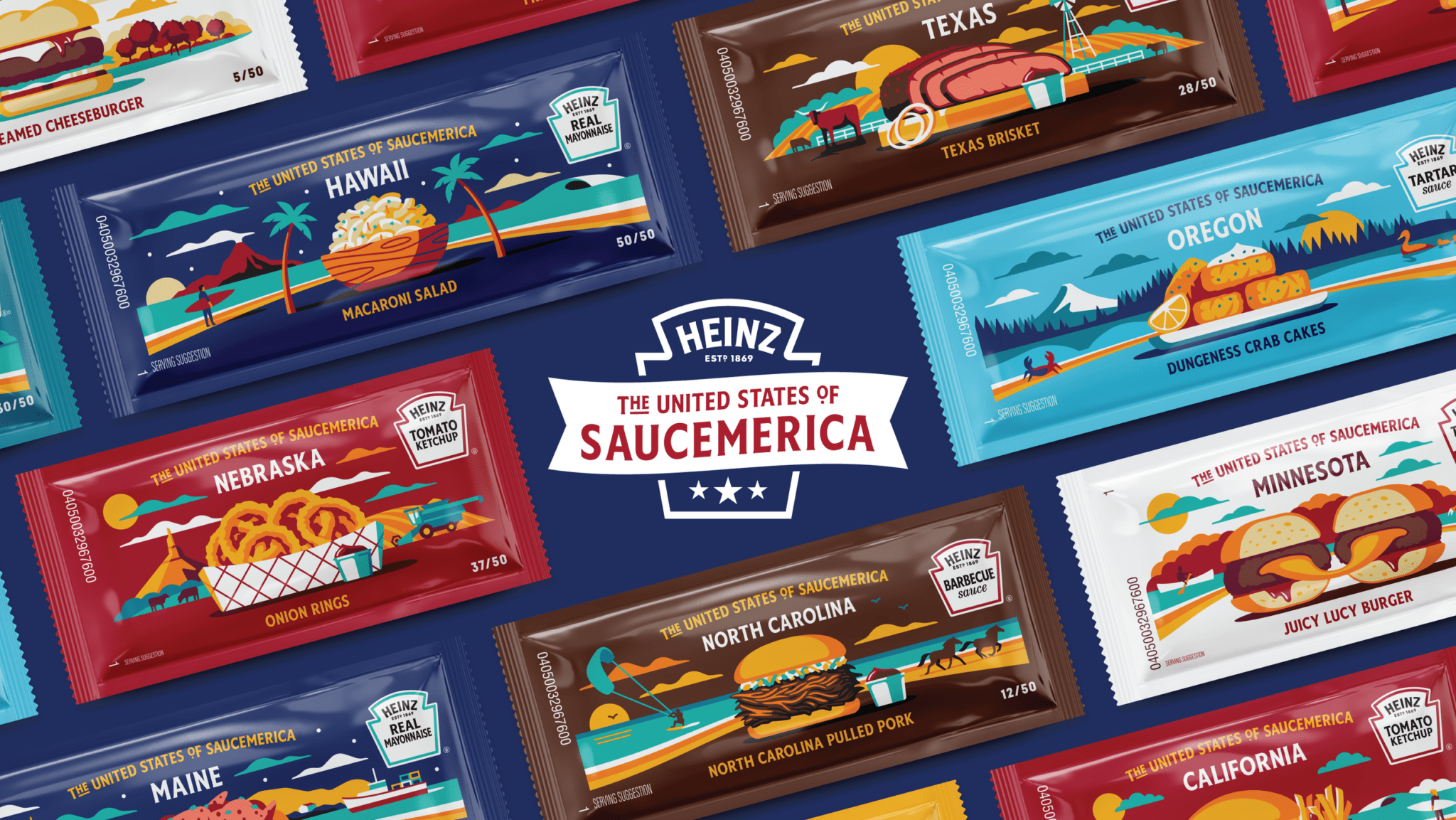
Case study:
Heinz, an international ketchup brand, has created a collectable sauce packet for all 50 US states, with each one highlighting a regional delicacy.
But these sauce packets aren’t easy to find, and collectors can win prizes up to $100,000 if they collect them all. Customers can also log onto the Heinz website and play a series of games to further immerse themselves into the Heinz universe. While it’s still early days, the campaign appears to be doing well.
How does this benefit bigger businesses?
The longer you are in business, and the bigger your business is, the easier it becomes to think smaller. Campaigns like this are inherently riskier, and far more expensive than a billboard, but their pay-off is much greater – and in a world that has diminishing opportunities for consumers to relax and enjoy themselves, brands becoming a source of entertainment is a quick way to both build their brand equity, and become known for something outside of their product.
How does this benefit smaller businesses?
It only takes one great immersive campaign to elevate a smaller business into a bigger business – but everything else tracks the same as for larger businesses. People are still bored. There’s less of the internet to just lose themselves in. The sense of FOMO and the sense of adventure is still prevalent. A small business that prioritises immersion in its products will draw attention, and pull consumers towards it.

Macro Trend 2: Humanmade
- 47% of UK consumers concerned they might end up interacting with AI more than people.
- 61% of US consumers do not consider AI-generated materials as art.
- More than half of US Consumers prefer human-created content to AI-generated content.
Can you tell the difference between content made by a machine and content made by humans?
Your consumers can.
2024 is going to be the start of a rising reliance on generative content using AI. As more tools become available faster and the bulk of creators turn to AI to streamline their process, content that is wholly crafted from start to finish by humans is going to matter more. Regardless of where you personally fall on the side of AI tools, or whether you show them as a positive or a negative aspect to your business, consumers still mistrust AI tools even as they use them.
On a more practical note, the same generative AI tools that we are using to generate that content are in their infancies, and the ongoing changes being continuously adapted to their datasets, the current discussion about the use of generative AI in Europe, and public opinion on the veracity of generative AI as a tool make this trend a little more complicated than just siding with one segment of your audience over another. Regardless of your final choice, human-created content isn’t on its way out: the exact opposite. As the market floods with AI-generated stories, videos, photographs, artworks, companies will be expected to push and protect human-created artworks over those that are made by generative AI.
This isn’t to say that generative AI shouldn’t, or can’t, be used in tandem with human content. Generative AI’s capacity to create is still considered impressive, just not solely on its own.
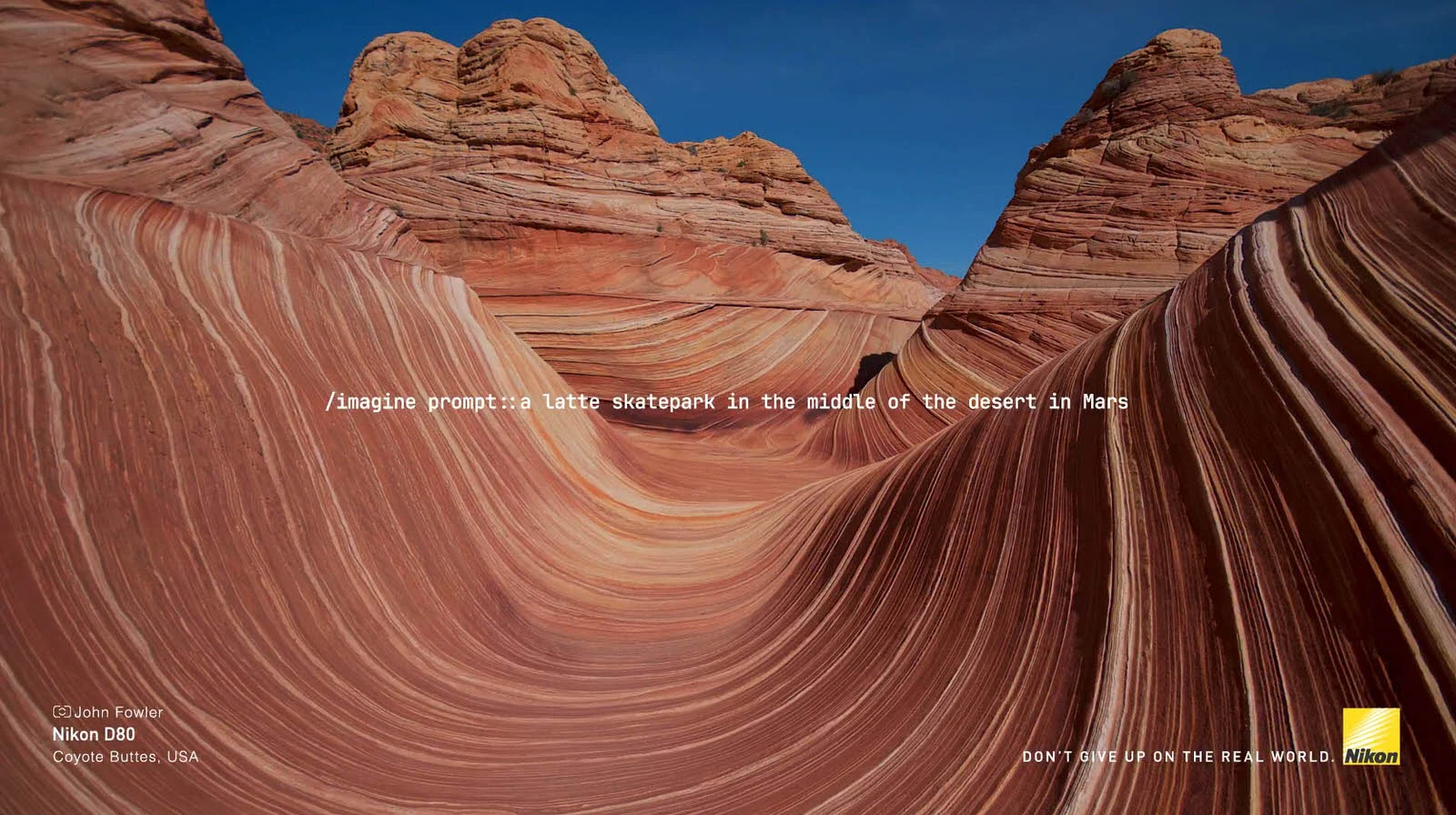
Case study
Nikon Peru’s ‘Natural Intelligence’ campaign debuted a handful of months ago, encouraging their consumers to pick up their cameras and fight against generative AI creation. Using real-life locations and photographs taken using Nikon cameras, each image is accompanied by a generative AI prompt that highlights how truth, in this case, is far stranger than our imagination.
How does this benefit large businesses?
It’s tempting to fall into the idea of using generative AI as your sole content creation machine, particularly if you’re only looking at cutting some costs and increasing productivity. Larger businesses have the capabilities of paying for unique artist collaborations that are used on their own or in tandem with AI. Regardless of company size, human-made content will sit at a higher premium, and as the AI tools that we use become even more intricate and hard to tell apart, consumers will look for content that they can definitively tell was created by humans.
How does this benefit small businesses?
In general, smaller businesses are trusted more than larger businesses, and the use of generative AI as their sole content creation method may have a negative effect on consumers’ opinion of the business, depending on how the business markets itself. Smaller companies that market themselves as artisanal or independent may find that consumer opinion is very quick to condemn solely AI-generated content, and that it goes against their business values in the eyes of their consumers.

Macro Trend 3: Money over Matter
- 78% of consumers consider themselves worse off heading into 2024.
- 69% of consumers have slowed down or pulled back on non-essential spending.
- 75% of consumers are worried about the price of essential goods.
Money has been a concern for three years running, so this isn’t really a new trend – but we’re likely to see the cost-of-living crisis worsen in 2024, unless something drastic changes the status quo.
Here’s the truth of the matter: consumers will still try and buy what they like, but with less disposable cash at hand, they’re going to scrutinise their purchases before they make them. Quality, durability, and whether or not they can use it repeatedly are going to be questions at the forefront of their minds, and with so much of the essentials becoming expensive, they’re not going to pay a penny more than the perceived value of the goods in mind.
To this end, brand value is going to skyrocket in importance. The perceived value of a brand by its consumers becomes one of the determining factors in whether or not your audience buys from you, whether they see brand value in the durability of the item, or in the legacy that it carries behind it. Legacy brands who have been in operation for years – such as 170-year-old clothing firm Levi’s, or similarly-aged camera company Leica – are going to be far more highly-rated than new brands, but to a certain extent, price and a good story can sway your consumers significantly.
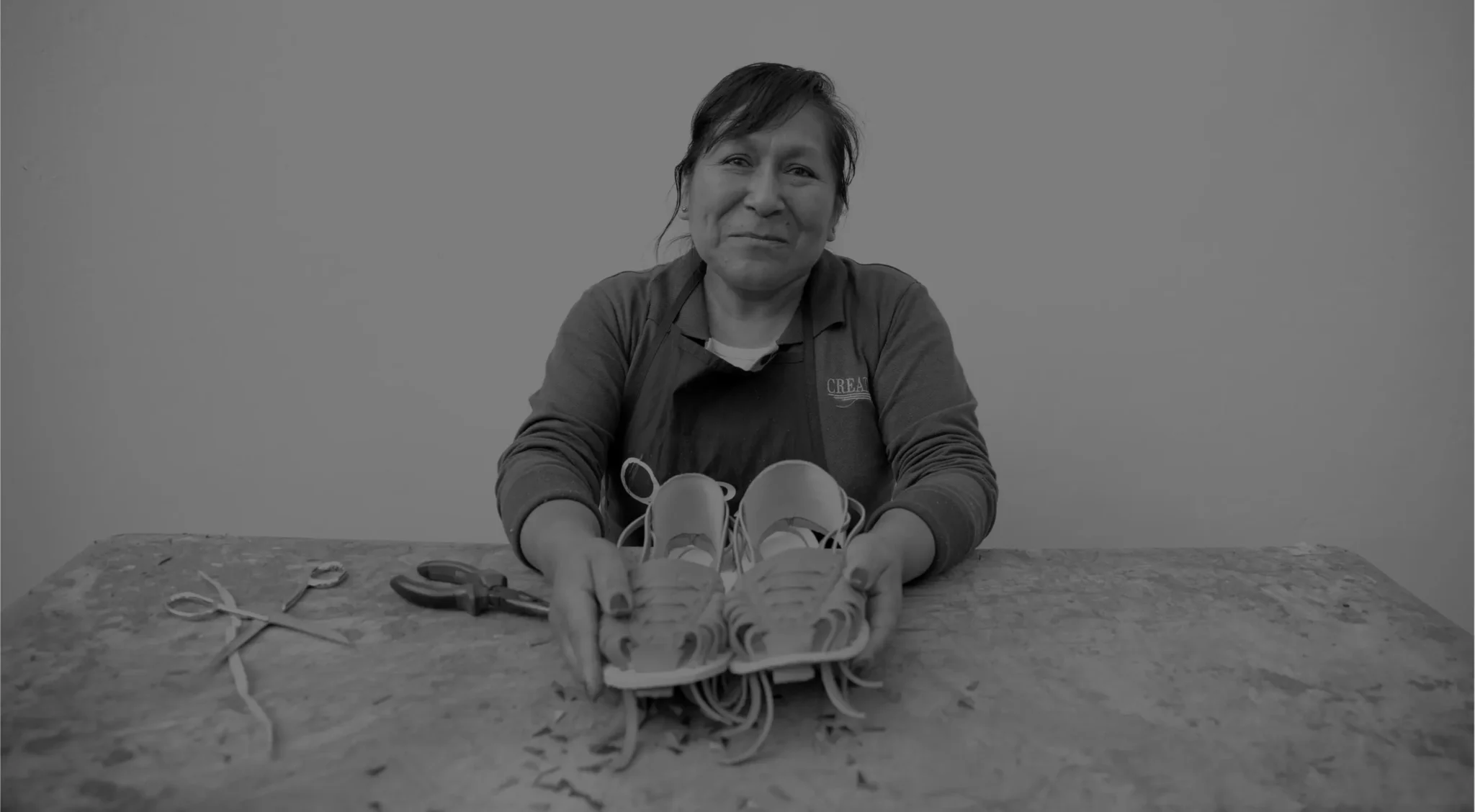
Case study
Nisolo, an American shoe manufacturer, ships every one of their products with a Sustainability Facts label that provides consumers with additional information on how their shoes are made. Subdivided into ten categories and featuring public data as their cornerstones, the Sustainability Facts label is intended to be used by the fashion industry to reduce the abuse and harm of an industry that is often obfuscated.
How does this benefit bigger businesses?
Businesses that have marketed a product well enough to grow significantly have one thing on their side that smaller businesses won’t have yet: legacy, heritage, and a story to tell. Legacy brands and brands that have been around long enough that the consumers’ ancestors would have used the item are going to attract attention, especially as the rising rates of practically everything else forces consumers to trim the fat from their lives, and focus only on bargains. Leaning into your heritage as a larger business, and highlighting your many years of service or your particular attention to detail, will do a lot to sway consumers to keep you when they cut everything else in their lives.
How does this benefit smaller businesses?
There are two separate paths that smaller businesses can take to benefit from this trend, and they’re these: add more freemium services to your already-existing product range, or focus on the durability and usability of your products.
Consumers who have turned away from legacy brands, or don’t have that necessary connection in the first place, are looking for products that have the same aspects of certain heritage brands without the steep price tag. Highlighting that you can use this product or this service for years without any additional incurred costs is a good way of getting consumers on your side.

Personality. Immersion. Quality.
2024 won’t change the game for most businesses, and it hasn’t drastically shifted where the goal posts are – but the importance of a good brand, a good story, and good communication have grown astronomically.
2024 will be a defining year for businesses. Second chances will be rarer: consumers are less likely to spend money on a product or a service they tried and didn’t like. Your brand’s value is going to be tied intrinsically to what people are willing to pay for it in a way that’s never been seen before.
But there’s hope. These trends show that there is light at the end of the tunnel – and that it’s just a little extra work before the payoff. As a business, these trends are going to help you decide where your business is going next, and whether it’s going to grow into a brand that will be active a hundred years from now.
And if you need help making sense of these trends for your industry, or you want to know how we got here, there’s a way to do that too.
We’ve published these trends reports for years. And we’re always willing to help – just drop us a line!




